Ann Pogrebitskiy, a sophomore actuarial science and finance major from Denver, Colorado, is studying abroad May 14-June 4 in Santiago, Chile as part of the College of Business Global Immersion program Chile: Business Hub of Latin America. She and her classmates will interact with local Chilean university students and learn essential finance concepts during the three week trip. She looks forward to experiencing a different culture, increasing her global awareness, hearing new stories and checking an item off her college bucket list.
6/2/17
 Our Group in Front of Universidad de Chile.
Our Group in Front of Universidad de Chile.
All Beginnings Have an End
When I first signed up for this program, I had no idea what it would be like. Besides fulfilling my international business credit requirement, all I wanted to get out of it was a cultural experience. And, boy, did I get that! From taking Spanish classes for 30 hours over the course of three weeks to going on business visits across Santiago, I have learned so much about Chile and the Latin American business world.
I have traveled to different places across the world, but this was my first time in South America. I think Chile was a perfect country to begin exploring. It offered a culture vastly different from the United States, a thriving business community that supports both start-ups and established firms and an environment where it is fun and exciting to live. To anyone considering studying abroad, do it! It is an amazing opportunity and an experience of a lifetime.
5/30/17
I just had the most amazing lunch. For $5500 CLP (~$8.50 USD), I had a full Chilean meal. Throughout the past couple of weeks, I have been trying to figure out exactly is signature Chilean food. I anticipated something along the lines of Mexican cuisine with lots of spices, rice and beans. I wasn’t wrong, but at the same time, I wasn’t right. The meal I had today, I think,is the perfect representation of Chilean food.
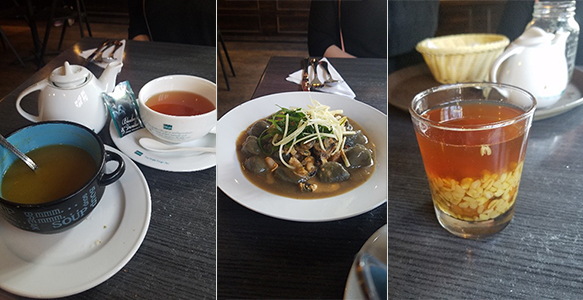 Chilean meal featuring zucchini soup, gnocchi (seafood pasta) and mote con huesillo.
Chilean meal featuring zucchini soup, gnocchi (seafood pasta) and mote con huesillo.
Because of Chile’s vast geography, the country is able to be self-sustainable (if it wanted to be) when it comes to its food. For my starter, I had a zucchini soup with fresh baked bread. Second only to copper, Chile’s main export is produce. From fruit to veggies, all of the produce sold both in supermarkets and on the streets is freshly picked and delivered from the valleys of the Andes just south of Santiago.
For my main course, I had a seafood and gnocchi pasta dish. When I first arrived in Chile, I was taken aback by the amount of non-Chilean international food around me: Peruvian, Italian, Mediterranean, even American. As I have learned more about the history of the country, I realized that similarly to the U.S., Chile is a country of immigrants. As people from all over the world moved to Chile, the cuisine changed to reflect that. In my main course, you can see that with the gnocchi. While originally an Italian dish, I have seen it offered at many different places, all with a unique Chilean flair. In particular, the dish that I had
, covered the gnocchi with either squid or octopus ink (I couldn’t tell which). I was a little wary at first, but it tastes is exactly the same. With a majority of Chile’s land consisting of coastline, it is very reasonable that after copper and produce, seafood is its next biggest export. All of the fish and shellfish I have had here has been amazingly fresh and delicious.
For dessert, I had a traditional Chilean drink called mote con huesillo. It is typically served in the summer and is known to be very refreshing. To continue with the produce trend, this drink consists of a dried apricot and barley (I think…) which is soaked in a sugary juice for a while so that both become very soft. To me, it tasted like a much fresher version of a canned peach. The thing that strikes me about this part of my meal was that everyone had told me how sweet it would be. Don’t get me wrong, it was very sweet, but it was sweet in the natural sense. Everything in Chile has a lot less spice/seasoning thanin other parts of Latin America. Even their desserts are not as sweet to me as an American. Although the locals claim that their desserts are way too sweet.
5/28/17
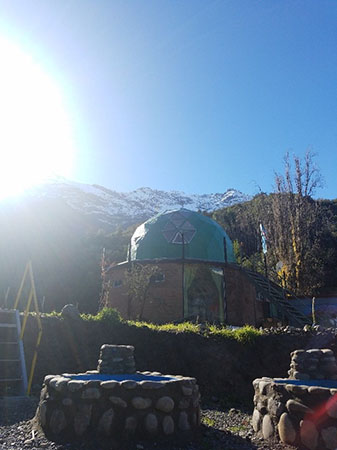 Adventures in the Andes at the Airbnb.
Adventures in the Andes at the Airbnb.
This past night was quite an adventure! A fellow Nebraska student, Michaela Schneider (senior accounting major from Springfield, Missouri), and I decided to travel to the Cajón del Maipo or the Maipo Canyon. We booked an Airbnb, figured out our travel plan and set off. Well, as always, getting there was the fun part! The buses in Chile are for the most part reliable, meaning they run on a pretty consistent schedule on pretty consistent routes. The issue we ran into, though, was that if the bus does not have any other passengers, and it is towards the end of the route, they will not take you any further. So once we got to the end of the last town, we were told to get off. The bus driver even helped us out by giving us directions on where we needed to walk to get to our destination.
The result: a walk in the Andes in the pitch dark, along a mountain and a river, for about 20 minutes. We knew where we were going so the worry was not about getting lost. In hindsight, it still makes me laugh thinking about it, but in the moment I was a tad bit freaked out. But that’s what studying abroad is for, right? Getting out of my comfort zone, trying new things, and going on adventures.
Once we reached our hostel, everything went smoothly from there. The host and greeter were so nice and accommodating. They told us stories, made us laugh, fed us hot chocolate and reminded us why we decided to go in the first place. Our room was on the second floor of this hostel shaped like a dome that had glass windows in the ceiling so we got to sleep under the stars. And boy were they beautiful. The one major perk of walking in the pitch dark were the stars. Because we were so far out from society, there was very little light pollution resulting in a breathtaking sky. I don’t think I have ever seen that many stars at once before, including the Milky Way.
5/24/17
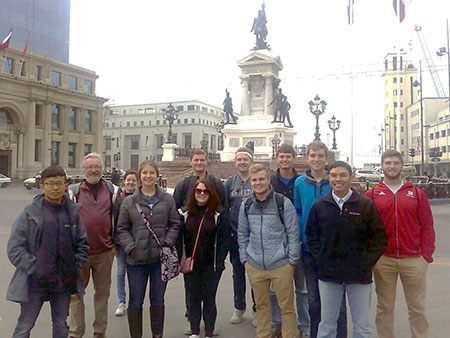 Students visited Valparaiso, the city on the sea.
Students visited Valparaiso, the city on the sea.
Before I get into my adventures in Valparaiso, I want to tell you a story. A long time ago, a little event called the California Gold Rush happened, causing thousands of people from all over the world to want to travel to the west coast of North America to either mine for gold, or trade for it. Of course, this was before the Panama Canal was built, so the easiest way for Europeans to get to California was to sail from Europe to one of their colonies in Central America, sail all the way around Cape Horn in Chile, and then back up along the western coast of Chile. At the time, this was a very long and dangerous journey that took months to complete so ships needed to stop many times for repairs and provisions. That’s how Valparaiso became the booming port city we visited today.
After an early start, it took us just under two hours to drive there by bus. There have been a couple of people who told me the first city they visited in Chile was Valparaiso and that it was there they decided they didn’t want to leave Chile. After visiting the city and learning about its history, I completely understand why. The beauty of the city is seen in the street art, the food, but mostly in the twists and turns of the roads and walkways that cover the city like a web. With mountains and hills covering the entire coast, the city had to move upward to expand. Thus, neighborhoods and communities developed within the valleys and on the hillsides. I will tell you from experience these hills, while filled with unbelievable beauty, are no fun to hike up and down all day. This caused grocery stores, schools and public spaces to be constructed right on the hills rather than on the flat ground below.
My favorite thing about Valparaiso – the thing that made it truly different from other Chilean cities – was the street art. The same artist that painted the murals in Santiago, Inti Castro, has painted many in Valparaiso. The street art here is borderline graffiti, but many of the shop owners will hire graffiti artists to paint their walls so taggers will not. Chile has gone through so much political turmoil in the past 50 years and the street art shows that. Many of the images portray deep political opinions and emotions. Next week we will be visiting the National Museum of Human Rights, so I will talk more about that later!
5/22/17
 View from the classroom.
View from the classroom.
These past couple of days have been one of insane beauty. As a little bit of background, Chile has a very diverse geography. To the west is the Pacific Ocean. To the east are the Andes mountains. To the north is the Atacama Desert, one of the driest areas of the Earth. Basically, Chile is isolated from the rest of South America due to its natural barriers. Here in Santiago, we are located in a valley of the Andes which causes issues like smog. With the hustle and bustle of being a big city, Santiago has a lot of air pollution most of the time. The exception is after it rains. On Thursday, there was a huge downpour with a gorgeous sight to see afterward.
We were sitting in the middle of our Spanish class on Friday when the clouds began to separate. Suddenly, I look over, and there are these absolutely stunning mountains outside of our window that I had never seen before. That afternoon we had some free time. In Santiago, there is a large hill in the middle of the city called Cerro San Cristóbal, the San Cristobal Hill. This hill towers 300m over the city and has a 22m statue of the Blessed Virgin Mary. We decided that Friday after the rain was the perfect day to hike this hill. After a grueling 45 minute hike full of groaning, panting and sweating, we made it to the top. Boy, what a view!
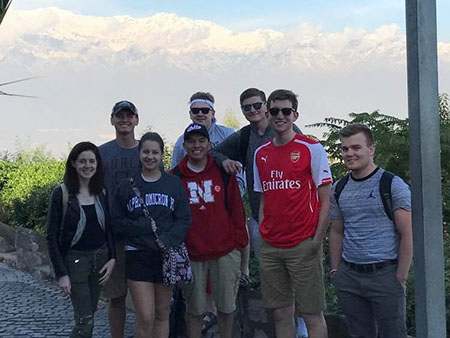 Making it to the top of San Cristobal Hill.
Making it to the top of San Cristobal Hill.
On Saturday, we traveled to the coastal cities of Viña del Mar and Reñaca. This was a big test of our navigational skills. The first legs of our journey went great. We successfully traveled by Metro to the central bus station without losing anyone (which has happened before…we found them eventually). With the help of my fellow student Eric, who speaks fluent Spanish, we purchased tickets and boarded a private bus to Viña del Mar. The two-hour bus ride was uneventful with most of us sleeping through the entire thing. We even were successful at navigating the local bus system to get to Reñaca which is where our Airbnb was located. This is where things got rough. We had previously entered the address into Google Maps and were following those directions to get to our house. Unfortunately, the place that Google Maps took us to was not the house we were supposed to be. The result was us waiting on the side of a very high-end looking condo building for our contact to find us, just to discover that our house was only a few blocks down the street. But in the end, we all made it and had a wonderful evening and next day on the beach enjoying the sunshine.
5/18/17
 Visiting one of the most influential Catholic churches in Santiago, Catedral Metropolitana de Santiago.
Visiting one of the most influential Catholic churches in Santiago, Catedral Metropolitana de Santiago.
It’s been a crazy couple of days and as always, expectations are very different from reality. When I thought about South America, I thought of warm weather; currently it is 35° and pouring rain. Secondly, I knew there would be a language barrier, but only about three percent of the population knows even basic English. Thirdly, I didn’t think the culture here would be drastically different from the U.S., and boy, was I wrong. We’ve been exploring Santiago and learning more about the local culture.
On Monday, we went on a walking tour of Santiago that highlighted Chile’s unique history and illuminated different parts of Chilean culture we would not have picked up otherwise. Throughout this tour, we encountered so many different historical and cultural places I would not have known if our tour guide hadn’t pointed out. As a humorous example, we learned how coffee shops in Chile have a unique history. Chile was originally conquered in the 16th century by the Spanish who were tea drinkers. The population had become so accustomed to drinking tea with lots of sugar that when there was a movement to become more westernized in the 1980s, it was very difficult to introduce coffee because it is so bitter. As a result, coffee shops had to get creative to attract customers to their business. And so, Café con Piernas or coffee with legs was born. It is exactly what it sounds like: their waitstaff wears revealing clothing. If our tour guide had not explained this to us, I totally would have accidentally walked in!
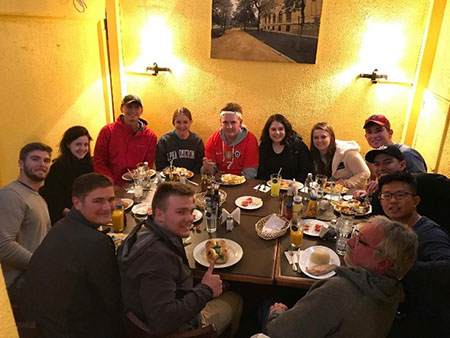 Classmates dine at Italian restaurant in Chile.
Classmates dine at Italian restaurant in Chile.
Another example is just simple table manners. The first night we were here, we went to a nice Chilean Italian restaurant. Throughout the dinner, we were getting very frustrated with their customer service – it took a while for drinks to arrive, each time we needed something we had to wave the server down, it took 30 minutes for us to get our check, etc. As we have spent time here, we have learned that Chileans are chill, pun intended. Here it is very common to people to sit for two, three, maybe even four hours for dinner sipping on a coffee or drink; they will not be hustled out like they would be in the U.S. In return, it makes sense waiters do not check in every 10 minutes. Not knowing these customs, we thought they just had really bad customer service. This sort of “chill” attitude is seen in so many different aspects. When standing in line at the grocery store, there is a long line, yet the cashier is still chatting it up with a customer. It all just comes down to the culture.
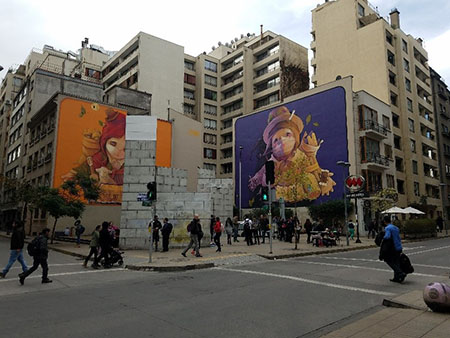 Mural depicting Chilean way of life.
Mural depicting Chilean way of life.
As a more materialistic example, these murals, painted by famous Chilean artist Inti Castro show the culture and customs of the people here. On the right side is the male. The mining hat and pick axe represent the importance of the mining industry to the nation. Copper mined from the northern mountains is the largest export of Chile. The bread on his back and peppers on his hat represent the large farming tradition in the rural parts of the country. On the left is the female. Of her symbols, the children on her back are the most symbolic, representing the importance of family to the Chilean way of life. Due to the Spanish influence, Catholicism is a very strong force that influences the way of life here. Often times, even for school, children will live with and rely on their families until marriage.
5/13/17
It’s finally here. After months of planning, weeks of meetings and days of anticipating, here I am sitting on the plane for the next eight hours. A plethora of emotions are running through my head, but the one I feel most acutely is excitement. Excitement for a new adventure.
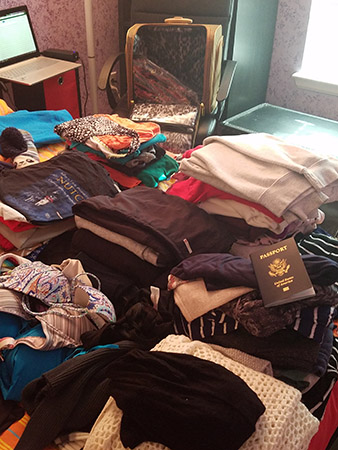 What do you take when you’re packing for adventure?
What do you take when you’re packing for adventure?
I caught the travel bug after my sophomore year of high school. That summer, I was so fortunate to be able to participate in an exchange program with Germany. In April, my family hosted my exchange sister and then in June, her family hosted me. This is when I fell in love with Germany, Europe and even more importantly, traveling. I knew then and there I would study abroad in college. In fact, that is one of the things I looked at when making that all important college decision. Originally, I was planning on going to Brazil, but when that program did not have enough interest, I quickly discovered the Chile program had even more to offer.
My biggest fear for this trip is the language barrier. As I mentioned before, I studied German, not Spanish, but I guess the best way to learn a language is to go to a country where they speak it. Although the program I am participating in focuses on business and will be taught in English, I really hope to pick up at least some Spanish in the three weeks I am there. Language is such an important part of a countries culture, and I want to experience Chile to its fullest, even if that means struggling for the first couple of days. I’m so excited for what sort of experiences the next three weeks will hold and I can’t wait to share them all with you!
Published: June 4, 2017